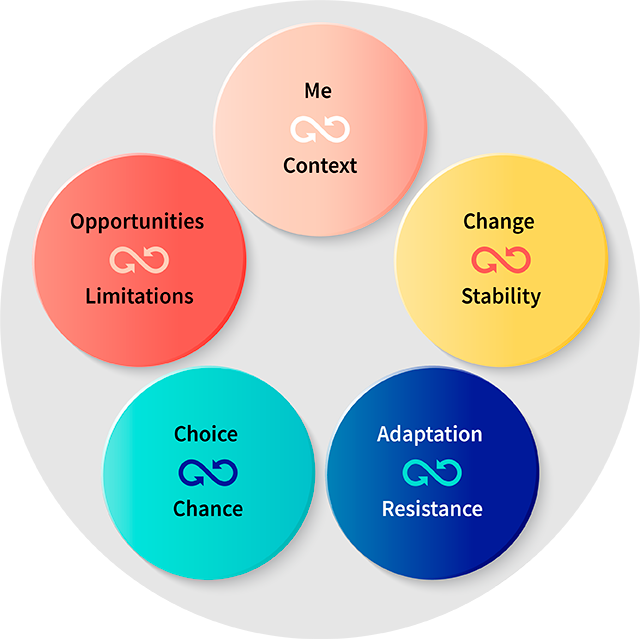Career learning in context model
At the core of the Career learning in context model, there are five pairs of words that make up the areas of exploration and learning – the career buttons.
Recently edited : 18. March 2024These word pairs make it possible to explore the tensions and dilemmas that can be present when a client is to handle life, learning and work in change and transitions. Exploring the word pairs and figuring out what impact the different topics can have on managing transitions, can facilitate an open, yet structured way of working with career learning.

Areas for exploration and learning

The areas for exploration and learning are general and generic indications of themes that could be relevant for exploration, and the objective is for the client to be able to develop and activate the career competences required by them at the time and in the situation when they are needed. The career competence areas provide practitioners/teachers and clients with a common language and a potential structure for exploration and learning.
The career competence areas are intended to contribute to the development of activities that support career learning in all sectors, for people of all ages and in different situations.
The five career competence areas
Me in Context

Me in context shows that people are always in a frame of reference, known as context. The context includes a person’s close contacts in a family, in a local community or other community, and in a greater society (such as the Norwegian society or the global society). Every person has a unique existence in the world. Every person’s presence can be explored, and this is what is in focus in this learning and exploration area. In career guidance, education and work form the pathway into the exploration, after which the exploration broadens, and in principle can include those aspects of a person’s life which they feel are important in relation to education and work.
Opportunities and limitations

Opportunities and limitations is about the individual’s opportunities and the horizon of opportunities within which they operate. Horizon of opportunities means what lies within an individual’s horizon, i.e. what they are aware of and consider in terms of opportunities for education and work.
This horizon may be wide or narrow. It can be limited by knowledge of and previous experience with education and work, by ideas and notions about education and work, and by the norms and expectations in the context of which one is part. Limitations are also explored in this area.
We can evaluate the individual’s situation with a view to clarifying limitations, and we can examine social conditions that can impose limitations on the individual’s choices, actions and participation (such as admission requirements, language skills, access to jobs in an industry, etc.). It may be relevant to examine whether perceived limitations, upon closer investigation, are not real limitations. The area provides the opportunity to examine limitations with a view to expanding alternative courses of action.
Choice and chance

Choice and chance focuses on making choices. The focus here is the competence that a person needs in order to manage choices and choice processes. A person will experience many different situations of choice throughout their life and career.
Sometimes there will be expectations that a choice must be made, such as the choice of education, choice of specialisation, choice of job. At other times, the choices will be less influenced by external expectations. Making choices is an absolutely essential part of career development, and something that an individual needs to manage. This area also draws attention to the elements of chance that may influence how a person’s life unfolds in terms of education and work.
There are many elements of chance in a person’s life; life is not lived independently of other people or events. Chance may be perceived as ‘wrong’, but it is also possible to examine how chance may positively influence the path someone takes through education and work.
Change and stability

Change and stability is based on the theory that living means being in a state of change and experiencing transitions. Quite simply, people experience change because they are people; a person’s biology develops, they age and go through different phases in their life. For example, a person’s values and wishes can gradually change as a consequence of what they experience in their life.
Change also occurs as a consequence of deliberate choices, external events and various types of institutional transitions. Change occurs in our lives or our minds, and change occurs outside ourselves, in external circumstances that can affect our situation and conditions. In the labour market, change can occur as a result of such things as technological developments, changes in the way work is organised, organisational changes, etc. These changes can also affect the individual’s situation and opportunities.
Adaptation and resistance

Adaptation and resistance focuses on the balance between adaptation and resistance in education and work. The area for exploration provides the opportunity to examine whether there are conflicts in the balance between adaptation and resistance, and to look for ways of managing these. Individuals are often expected to adapt, for example to the education system or to the conditions, expectations and requirements of the labour market.
This may not be a problem. However, in some situations individuals may need to demonstrate resistance to expectations of adaptations that go against their own wishes, needs, values, attitudes or integrity. In education, the labour market and career, there can be a continuous ‘negotiation’ between adaptation and resistance. In some situations, the two can come into conflict with each other, and a choice must be made. It can then be necessary to assess whether one should, for example, adapt to new requirements in a job or leave the job, or whether one should complete a course of education in which one has lost interest.



